The NVIDIA GeForce RTX 2070 Founders Edition Review: Mid-Range Turing, High-End Price
by Nate Oh on October 16, 2018 9:00 AM ESTCompute & Synthetics
Shifting gears, we'll look at the compute and synthetic aspects of the RTX 2070. Though it has its own GPU in the form of TU106, the hardware resources at hand are similar in progression to what we've seen in TU102 and TU104.
Starting off with GEMM tests, the RTX 2070's tensor cores are pulled into action with half-precision matrix multiplication, though using binaries originally compiled for Volta. Because Turing is backwards compatible and in the same compute capability family as Volta (sm_75 compared to Volta's sm_70), the benchmark continues to work out-of-the-box, though without any Turing optimizations.
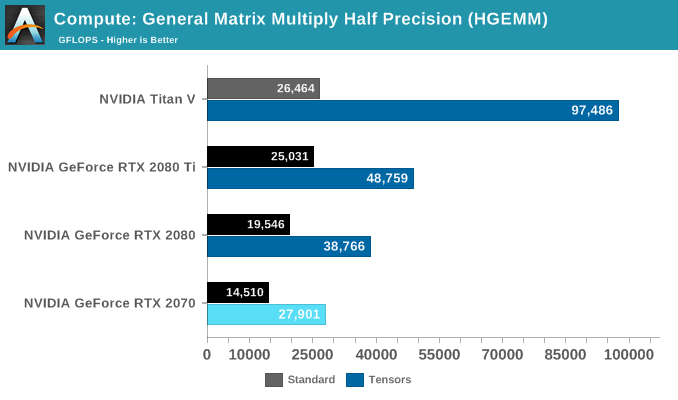
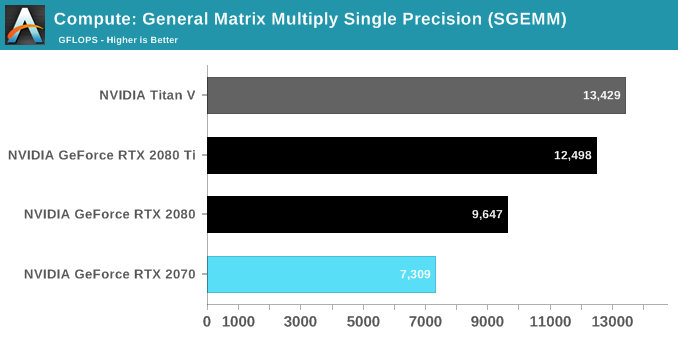
At reference specifications, peak theoretical tensor throughput is around 107.6 TFLOPS for the RTX 2080 Ti, 80.5 TFLOPS for the RTX 2080, and 59.7 TFLOPS for the RTX 2070. Unlike the 89% efficiency with the Titan V's 97.5 TFLOPS, the RTX cards are essentially at half that level, with around 47%, 48%, and 45% efficiency for the RTX 2080 Ti, 2080, and 2070 respectively. A Turing-optimized binary should bring that up, though it is possible that the GeForce RTX cards may not be designed for efficient tensor FP16 operations as opposed to the INT dot-product acceleration. After all, the GeForce RTX cards are for consumers and ostensibly intended for inferencing rather than training, which is the reasoning for the new INT support in Turing tensor cores.
In terms of SGEMM efficiency though, the RTX 2070 is hitting a ridiculous 97% of its touted 7.5 TFLOPS, though to be fair the reference specifications here are done manually rather with a reference vBIOS. The other two GeForce RTX cards are at similar 90+% levels of efficiency, though a GEMM test like this is specifically designed for maximum utilization.
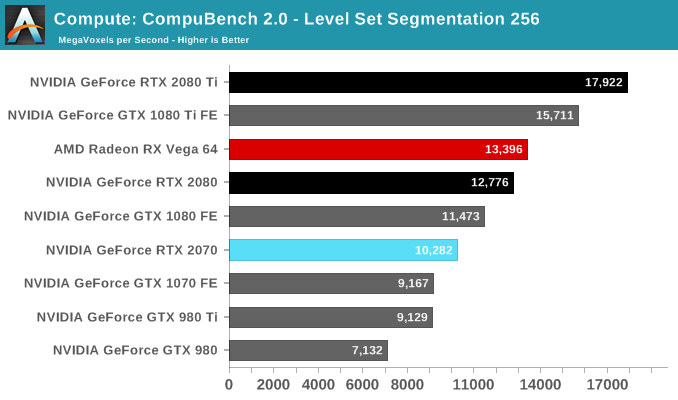
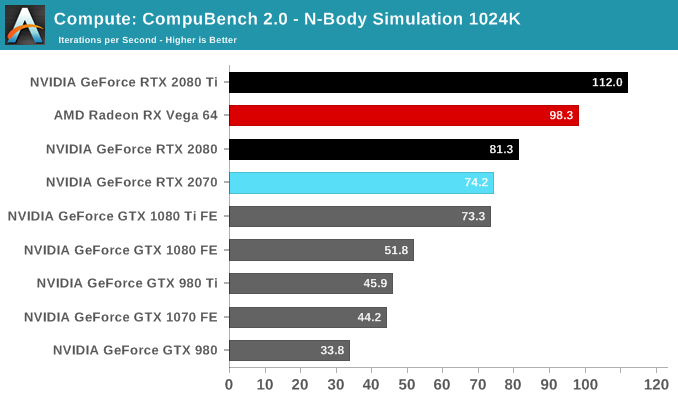
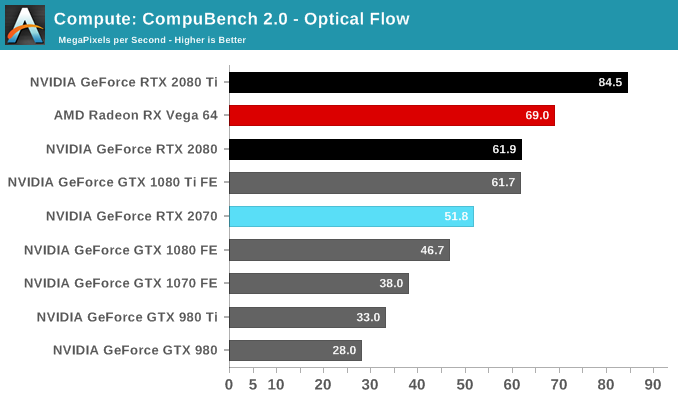
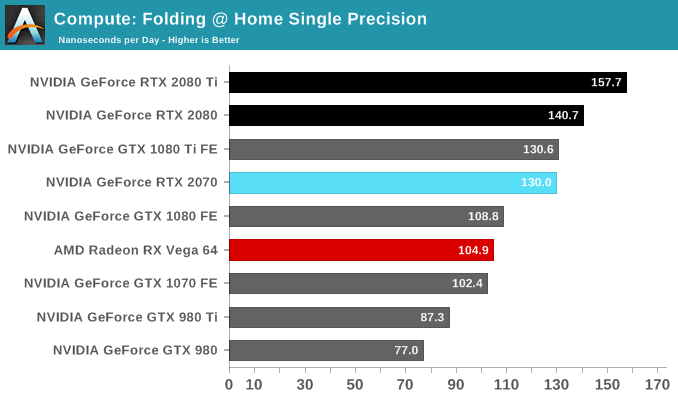
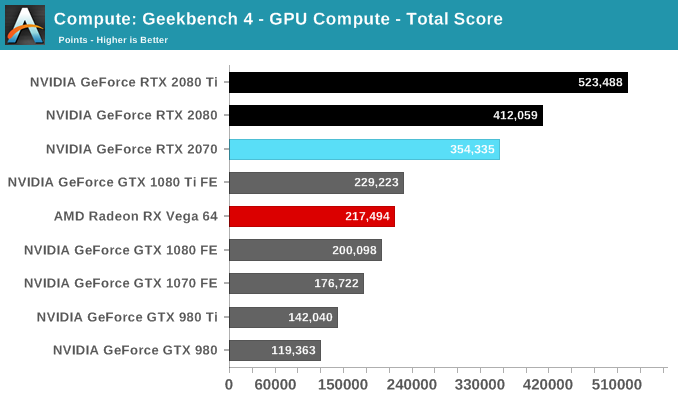
The breakdown of the GB4 subscores seems to reveal a similar uplift like we spotted with the Titan V, which had scored in excess of 509,000 points. We'll have to investigate further but Turing and Volta are clearly accelerating some of these workloads beyond what was capable in Pascal and Maxwell.
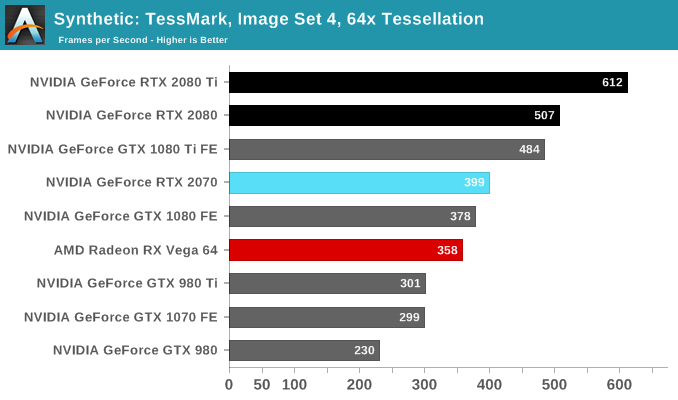
Given that TU106 has 75% of the hardware resources of TU104, the tessellation performance is in line with expectrations. For reference, we noted earlier that the Titan V scored 703 while the Titan Xp scored 604.
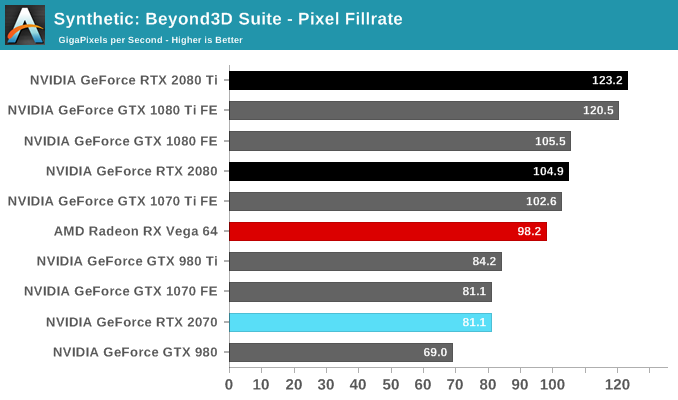
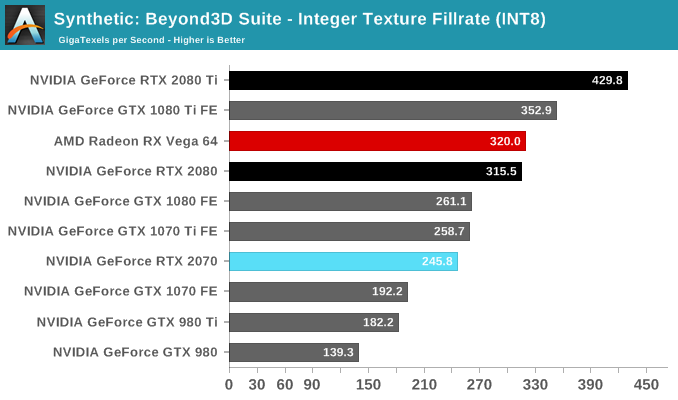










121 Comments
View All Comments
TheinsanegamerN - Tuesday, October 16, 2018 - link
Because the 2070 is a 1070 replacement? Why do you people get hung up on "WELL IT COST A BUNCH SO ITS A HIGH TIER CARD"No, it isnt, its a mid tier card with a high tier pricetag. It doesnt make sense to compare the 2070 to a 1080ti because of the pricetag, anymore then comparing a vega 64 to a 1070 because they both cost $400 at some point.
ioni - Tuesday, October 16, 2018 - link
2070's die size is closer to the 1080 ti than it is to the 1080. It should be, at minimum, being compared to a 1080.Nioktefe - Tuesday, October 16, 2018 - link
Exactly, it could be called RTX 2050 and still use the same chip, don't compare marketing with die specifications, RTX chips are huge, and they are priced accordingly to that, we will never see 2080Ti come close to 1080ti pricesPeachNCream - Tuesday, October 16, 2018 - link
^^ So much of this right here! Name it what whatever, but the retail price is ultimately what dictates what it must compete with from prior generations or from the nearest competitor. As far as pricing is concerned, the RTX 2070 must contend with the GTX 1080Ti and 1080 when a present day buyer is looking at options in that price range.tamalero - Wednesday, October 17, 2018 - link
die size is irrelevant, price points is what is important in price brackets.. if the 2070 is on 1080gtx prices for a tiny improvement, its not worth it..Vayra - Monday, October 22, 2018 - link
Die size is not irrelevant. Cause & Effect: larger die = lower yield per wafer = higher price.CheapSushi - Thursday, October 18, 2018 - link
Do you make your choice based on die size OR price?dguy6789 - Tuesday, October 16, 2018 - link
What an absolutely ridiculous statement. People don't cross shop products that have radically different pricing- they pick a budget and look for what is best in that price segment. Hmmm I'm torn between a Kia and a BMW. Yeah right.evilspoons - Wednesday, October 17, 2018 - link
That's reasonable, the Kia Stinger is a pretty decent RWD/AWD luxury sedan. For like $45k CAD you get roughly what you'd have to pay $65k CAD to get in a BMW, so a $45k BMW by contrast is a much less interesting vehicle. (Although personally, I'd go with the Genesis G70 instead of the Kia, you can get it with a 6-speed manual.)khanikun - Friday, October 19, 2018 - link
Car analogies do and don't work here. Some might start with size, while other start with price. Some will start with looks, some will start with power, some will start with drivetrain, etc. Some will cross shop products that have different prices, some won't.Some might be torn between a Kia and a BMW, if both made rwd sports cars that compete against each other, even with a price tag difference. Look at all the comparisons between something like a Subaru WRX STI vs a BMW M3, even though the M3 is easily $20k over the STI.
The only time I see someone set a budget first, is those looking at the used car market. Not the looking at the new car market.